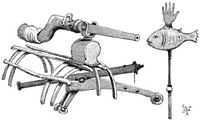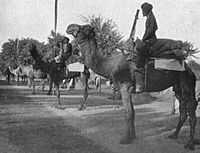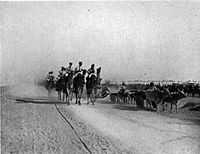Zamburak

A zamburak or zumbooruk was a specialized form of mobile artillery from the early modern era. The operator of a zumbooruk is known as a zamburakchi or zumboorukchee. The weapon was used by the Gunpowder Empires, especially the Persian empires of the Safavids & Afsharids due to the ruggedness of the Iranian plateau which made transportation of heavy cannon problematic.
The zamburak became a deadly weapon in the eighteenth century. The Afghans used it to deadly effect in the Battle of Gulnabad where they routed a Persian army. However the most successful application of the zamburak would take place in the Naderian Wars when the military genius Nader Shah would utilise a zamburak corps in conjunction to a regular artillery corps (consisting of conventional cannon) to devastating effect in numerous battles such as at Mihmandust, Baghavard and Karnal.
Use
Probably developed by Egyptian warriors who originally mounted large crossbows on the camels, the zumbooruck was rapidly adopted by Arab, Afghan, Mughal and especially Persian Safavid armies up until the 19th and 20th century India. Zumboorucks were one of the royal guard units in the 19th-century Persian army. A Persian zumbooruck regiment would be accompanied by musicians with huge camel-mounted drums, in order to create even more noise and impress the enemy. Zumboorucks were used against the invading British in the Anglo-Afghan Wars and in the Anglo-Sikh Wars.
A zumbooruck consisted of a soldier on a camel with a mounted swivel gun (a small falconet), which was hinged on a metal fork-rest protruding from the saddle of the animal. In order to fire the cannon, the camel would be put on its knees. The name may be derived from Arabic zambūr, hornet (possibly in reference to the sound earlier camel-mounted crossbows made). The mobility of the camel combined with the flexibility and heavy firepower of the swivel gun made for an intimidating military unit, although the accuracy and range of the cannon was rather low. The light cannon was also not particularly useful against heavy fortifications.
A later development (after 1850) would see Gatling guns mounted on camels as well.
See also
Sources
- Biblomania: Free Online Literature and Study Guides
- Hobson-Jobson
- digital.library.upenn.edu/women/sheil/persia/185.jpeg an image
- Answers.com entry (citing 1913 Webster's Dictionary)
- Thefreedictionary.com entry

